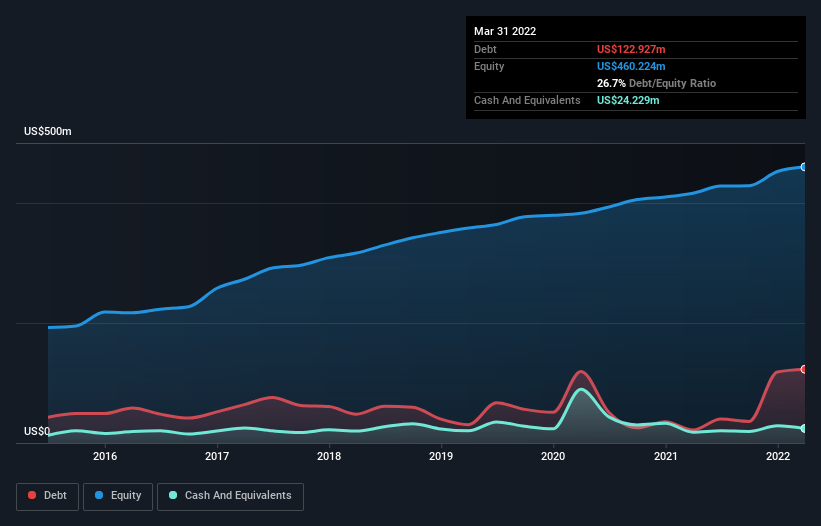- United States
- /
- Healthcare Services
- /
- NYSE:USPH
Is U.S. Physical Therapy (NYSE:USPH) Using Too Much Debt?

Howard Marks put it nicely when he said that, rather than worrying about share price volatility, 'The possibility of permanent loss is the risk I worry about... and every practical investor I know worries about.' So it might be obvious that you need to consider debt, when you think about how risky any given stock is, because too much debt can sink a company. Importantly, U.S. Physical Therapy, Inc. (NYSE:USPH) does carry debt. But should shareholders be worried about its use of debt?
What Risk Does Debt Bring?
Debt is a tool to help businesses grow, but if a business is incapable of paying off its lenders, then it exists at their mercy. In the worst case scenario, a company can go bankrupt if it cannot pay its creditors. However, a more frequent (but still costly) occurrence is where a company must issue shares at bargain-basement prices, permanently diluting shareholders, just to shore up its balance sheet. Of course, the upside of debt is that it often represents cheap capital, especially when it replaces dilution in a company with the ability to reinvest at high rates of return. The first thing to do when considering how much debt a business uses is to look at its cash and debt together.
See our latest analysis for U.S. Physical Therapy
How Much Debt Does U.S. Physical Therapy Carry?
The image below, which you can click on for greater detail, shows that at March 2022 U.S. Physical Therapy had debt of US$122.9m, up from US$21.7m in one year. On the flip side, it has US$24.2m in cash leading to net debt of about US$98.7m.

A Look At U.S. Physical Therapy's Liabilities
We can see from the most recent balance sheet that U.S. Physical Therapy had liabilities of US$89.0m falling due within a year, and liabilities of US$214.6m due beyond that. Offsetting these obligations, it had cash of US$24.2m as well as receivables valued at US$67.6m due within 12 months. So its liabilities outweigh the sum of its cash and (near-term) receivables by US$211.8m.
Of course, U.S. Physical Therapy has a market capitalization of US$1.40b, so these liabilities are probably manageable. However, we do think it is worth keeping an eye on its balance sheet strength, as it may change over time.
In order to size up a company's debt relative to its earnings, we calculate its net debt divided by its earnings before interest, tax, depreciation, and amortization (EBITDA) and its earnings before interest and tax (EBIT) divided by its interest expense (its interest cover). Thus we consider debt relative to earnings both with and without depreciation and amortization expenses.
U.S. Physical Therapy has a low net debt to EBITDA ratio of only 1.2. And its EBIT covers its interest expense a whopping 67.6 times over. So we're pretty relaxed about its super-conservative use of debt. And we also note warmly that U.S. Physical Therapy grew its EBIT by 11% last year, making its debt load easier to handle. The balance sheet is clearly the area to focus on when you are analysing debt. But ultimately the future profitability of the business will decide if U.S. Physical Therapy can strengthen its balance sheet over time. So if you're focused on the future you can check out this free report showing analyst profit forecasts.
Finally, while the tax-man may adore accounting profits, lenders only accept cold hard cash. So we clearly need to look at whether that EBIT is leading to corresponding free cash flow. Happily for any shareholders, U.S. Physical Therapy actually produced more free cash flow than EBIT over the last three years. That sort of strong cash conversion gets us as excited as the crowd when the beat drops at a Daft Punk concert.
Our View
Happily, U.S. Physical Therapy's impressive interest cover implies it has the upper hand on its debt. And the good news does not stop there, as its conversion of EBIT to free cash flow also supports that impression! It's also worth noting that U.S. Physical Therapy is in the Healthcare industry, which is often considered to be quite defensive. Zooming out, U.S. Physical Therapy seems to use debt quite reasonably; and that gets the nod from us. While debt does bring risk, when used wisely it can also bring a higher return on equity. The balance sheet is clearly the area to focus on when you are analysing debt. But ultimately, every company can contain risks that exist outside of the balance sheet. We've identified 1 warning sign with U.S. Physical Therapy , and understanding them should be part of your investment process.
If you're interested in investing in businesses that can grow profits without the burden of debt, then check out this free list of growing businesses that have net cash on the balance sheet.
New: AI Stock Screener & Alerts
Our new AI Stock Screener scans the market every day to uncover opportunities.
• Dividend Powerhouses (3%+ Yield)
• Undervalued Small Caps with Insider Buying
• High growth Tech and AI Companies
Or build your own from over 50 metrics.
Have feedback on this article? Concerned about the content? Get in touch with us directly. Alternatively, email editorial-team (at) simplywallst.com.
This article by Simply Wall St is general in nature. We provide commentary based on historical data and analyst forecasts only using an unbiased methodology and our articles are not intended to be financial advice. It does not constitute a recommendation to buy or sell any stock, and does not take account of your objectives, or your financial situation. We aim to bring you long-term focused analysis driven by fundamental data. Note that our analysis may not factor in the latest price-sensitive company announcements or qualitative material. Simply Wall St has no position in any stocks mentioned.
About NYSE:USPH
U.S. Physical Therapy
Operates and manages outpatient physical therapy clinics.
Excellent balance sheet with proven track record and pays a dividend.
Similar Companies
Market Insights
Community Narratives




